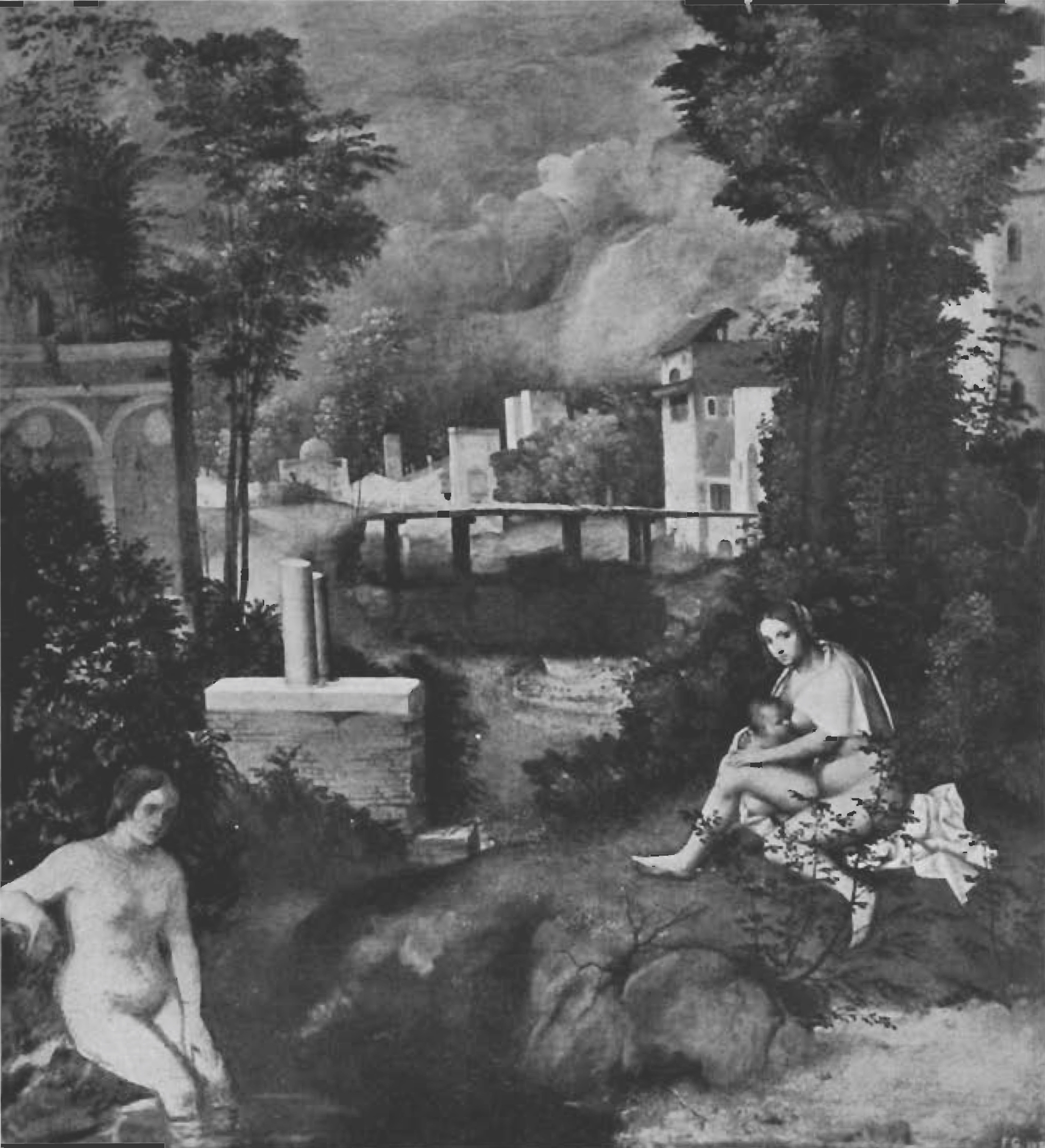In the distance, lightning strikes. What does it mean? Poetic and evocative, this painting invites interpretation.
Giorgione, The Tempest, c. 1505–08, oil with traces of tempera on canvas, 82 x 73 cm (Gallerie dell’Accademia, Venice). Speakers: Dr. Steven Zucker and Dr. Beth Harris
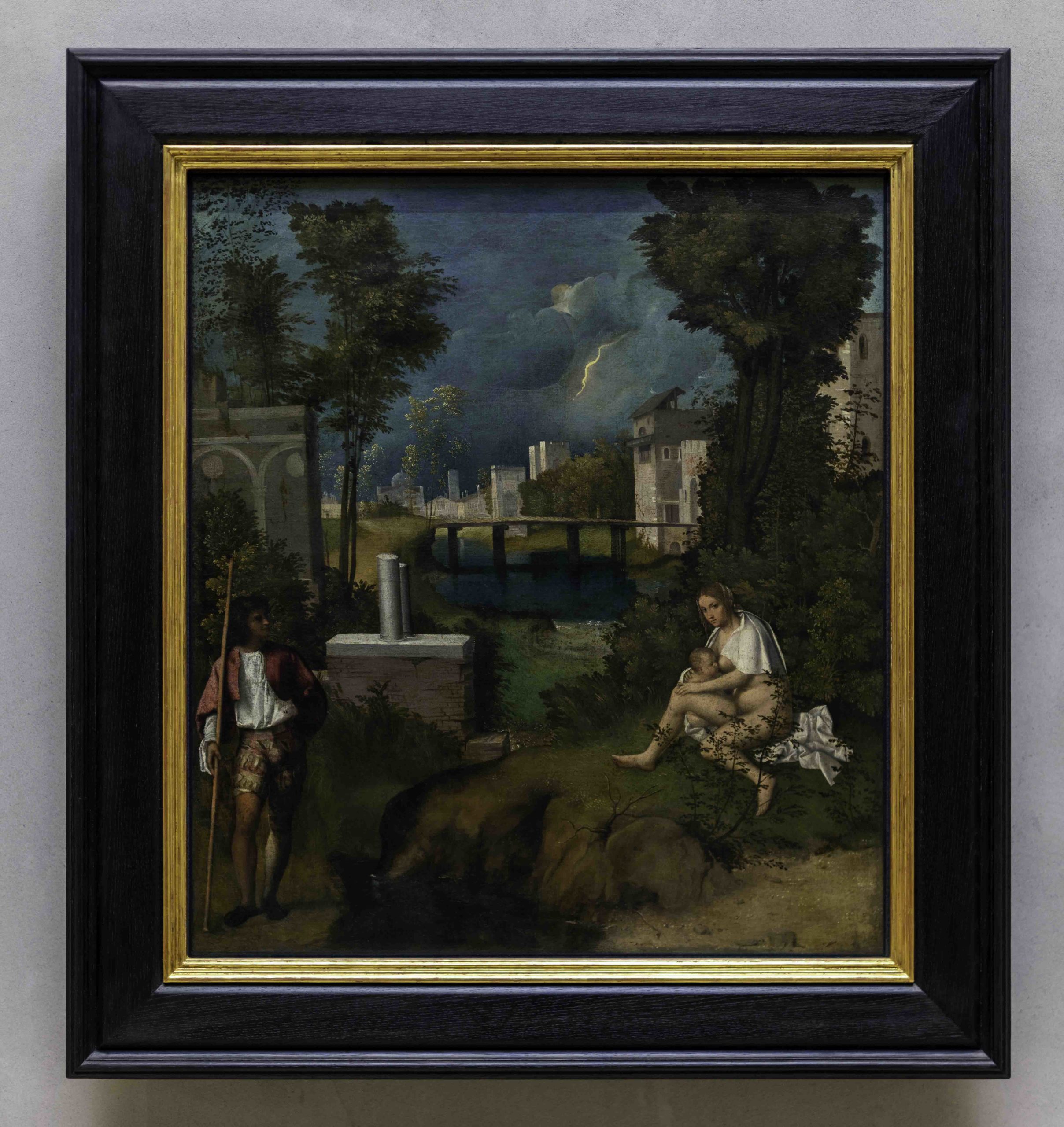
Giorgione, The Tempest, c. 1505-1508, oil with traces of tempera on canvas, 82 x 73 cm (Gallerie dell’Accademia, Venice) (photo: Steven Zucker, CC BY-NC-SA 2.0)
What is so tempting?
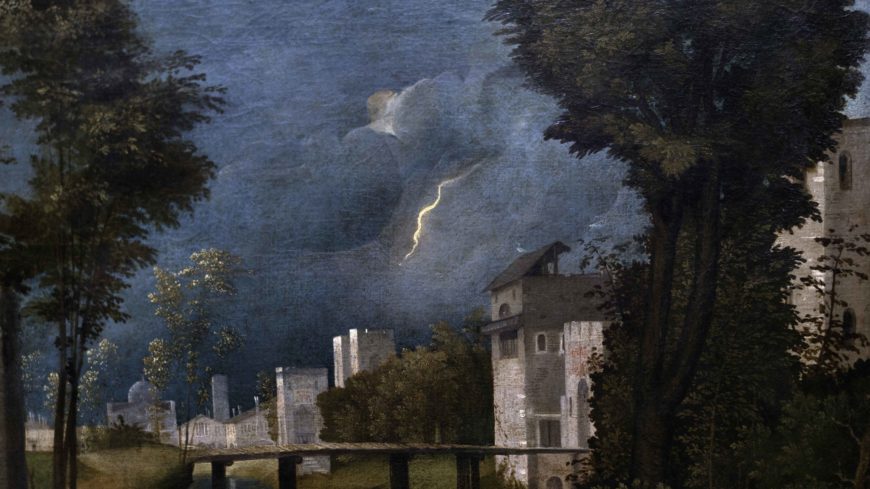
Lightning (detail), Giorgione, The Tempest, c. 1505-1508, oil with traces of tempera on canvas, 82 x 73 cm (Gallerie dell’Accademia, Venice) (photo: Steven Zucker, CC BY-NC-SA 2.0)
A burst of lightning illuminates a countryside engulfed in a thunderstorm. Its sudden flash reveals a curious scene: a fashionably dressed man standing on a riverbank eyeing a nearly nude woman seated on the opposite shore nursing an infant. The figures are alone in an otherwise lush landscape that glows turquoise in the storm’s humid air. Groves of tall trees flank a deep view extending backwards along a central waterway to a rural town on the horizon. The breastfeeding woman gazes outward as if questioning our intrusion upon the secluded rustic scene.
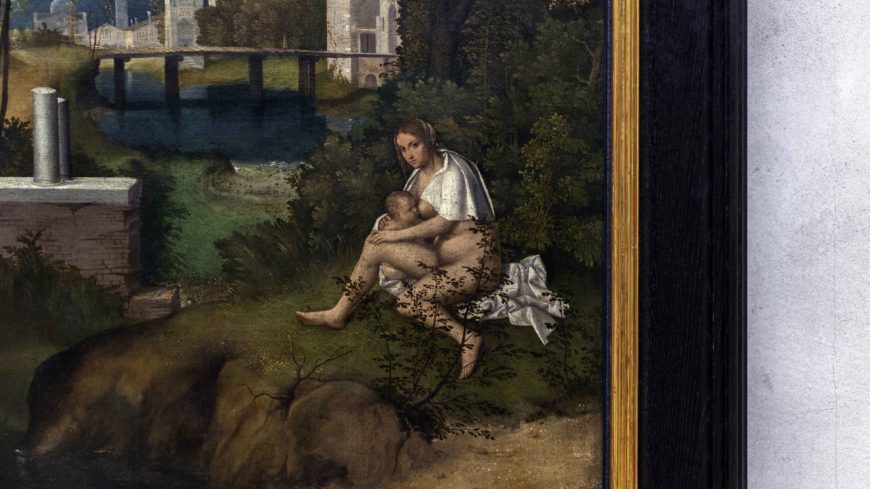
Woman nursing an infant (detail), Giorgione, The Tempest, c. 1505-1508, oil with traces of tempera on canvas, 82 x 73 cm (Gallerie dell’Accademia, Venice) (photo: Steven Zucker, CC BY-NC-SA 2.0)
Few paintings, if any, in the history of European art vex art historians as much as Giorgione’s Tempest. Painted in Venice sometime between 1505 and 1508, it has generated a steady flood of conflicting interpretations bent upon discovering its precise meaning. No consensus has been reached that fully explains its ambiguous imagery. Studying Giorgione presents a conundrum since little is securely known about his artworks, patrons, or life (cut short by his death from the plague in 1510)—yet he exerted considerable influence on the subsequent history of Venetian painting. Innovations evident in The Tempest showcase Giorgione’s technical experimentation and increasingly novel subjects that reshaped European easel painting.
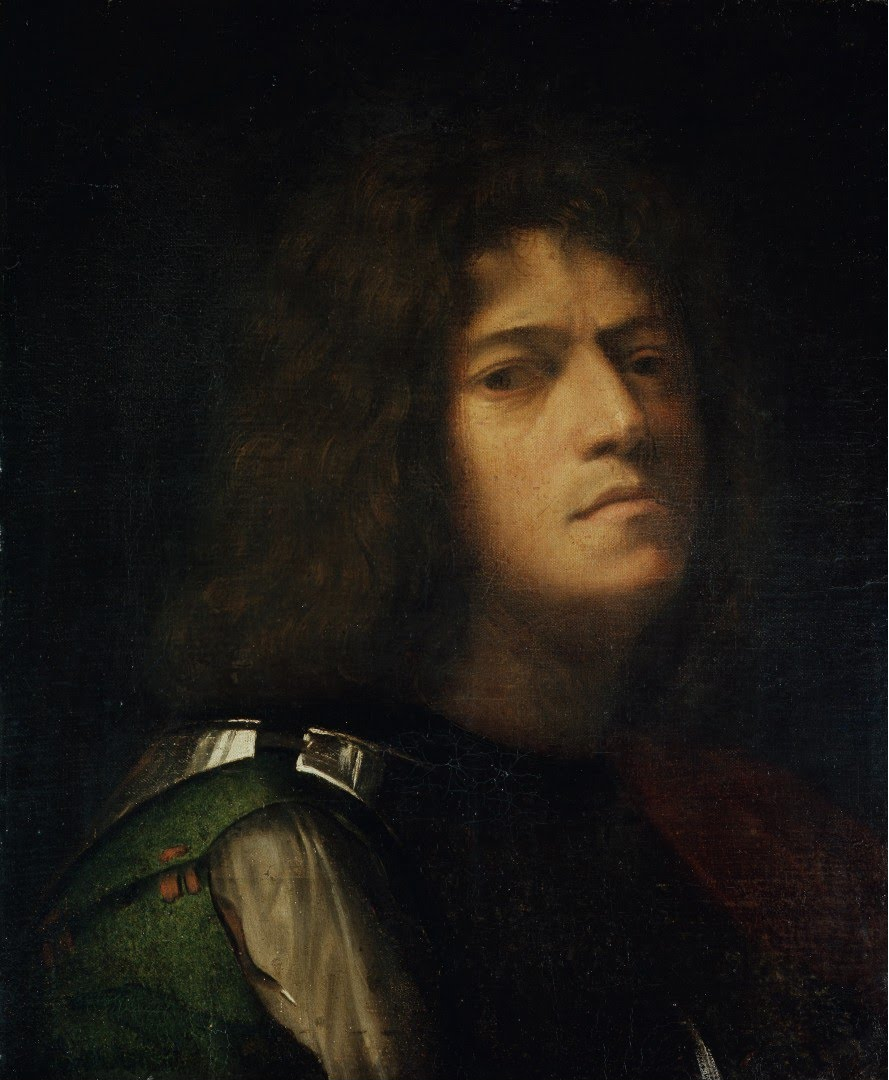
Giorgione, Self-Portrait as David, c. 1510, oil on canvas, 52 x 43 cm (Herzog Anton Ulrich-Museum, Braunschweig)
A downpour of interpretations
One of the central controversies viewers of The Tempest must face is making sense of its subject matter and meaning. Even sophisticated art connoisseurs in the sixteenth century puzzled over its imagery. The first recorded viewer in 1530 identified its figures but not any overarching narrative or theme. One of Giorgione’s earliest biographers, Giorgio Vasari, lamented in annoyance that he could not understand the meaning of the artist’s public paintings, nor supposedly could other learned viewers around Venice. Inventories likewise only vaguely identify the Tempest’s male figure as a “soldier” or “shepherd,” and the female figure as a “gypsy” or even more generically as a “woman.”
Many commentators, insisting Giorgione intended a preconceived theme in The Tempest, have been lured to resolve such enigmatic details. The painting has generated an enormous modern scholarly literature, with over 100 proposals for its imagery—nearly all of them different. Despite this, most interpretations tend to cluster around four main strategies. The first approach seeks to decode the picture’s iconography (its presumed textual or literary sources) to unveil a hidden symbolic narrative. Stories from mythology, classical history, religion, bucolic poetry, and humanist texts have all been linked to it. A second approach connects its prominent outdoor setting to landscape painting’s emerging popularity within aesthetic tastes and Italian art theory in the early sixteenth century.
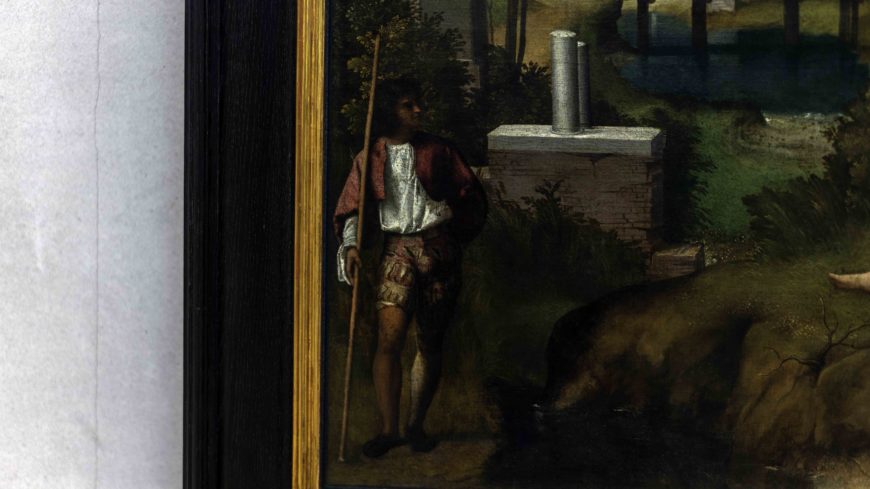
Male figure (detail), Giorgione, The Tempest, c. 1505-1508, oil with traces of tempera on canvas, 82 x 73 cm (Gallerie dell’Accademia, Venice) (photo: Steven Zucker, CC BY-NC-SA 2.0)
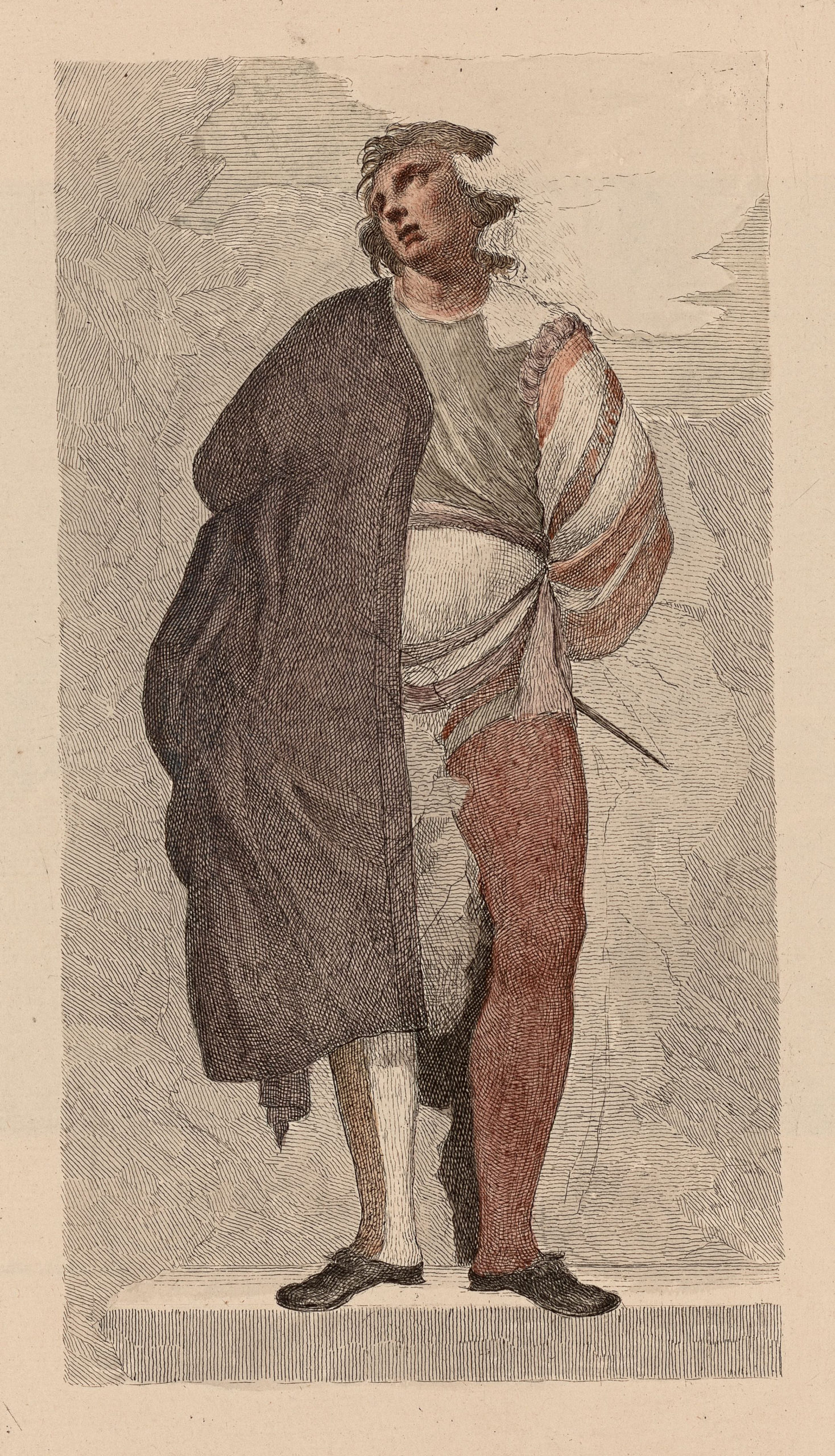
Anton Maria Zanetti II, 1760, engraving with watercolor, after Giorgione’s Compagno della Calza fresco from the façade of the Fondaco dei Tedeschi on the Grand Canal in Venice
Yet a third approach interprets Giorgione’s landscape as a socio-political allegory of the Veneto region. The Tempest, according to these hypotheses, represents a deeply nostalgic vision of Venetian territory as a peaceful Golden Age Arcadia during a period when the Veneto region was in fact under siege from foreign armies during the War of the League of Cambrai (1508–17). For other art historians, the male figure’s multicolored hosiery and fancy jacket correspond to theatrical costumes of Venetian Compagnie della Calza (Confraternities of the Sock), who often staged plays with rustic countryside settings resembling Giorgione’s landscape.
In sharp contrast is a final interpretive approach proposing that Giorgione’s Tempest lacks any primary subject matter or theme whatsoever. Instead, some art historians argue it exists as a capriccio (an imaginary topographical scene) or fantasia (fantasy) whose meaning is intentionally left open. In this line of reasoning, with The Tempest Giorgione invents the Renaissance genre of poesia (pl. poesie). This mode of painting aspires to the highly lyrical and musical qualities of verse, and resembles visual poetry meant to generate multi-layered responses.
Audiences for landscape painting
The Tempest is among the first paintings to be labeled a “landscape” in Western art history. Giorgione thus plays a key role in the rising status of landscape painting during the early sixteenth century in Italy and northern Europe. Particularly in Venice, relatively small cabinet pictures such as The Tempest depicting scenes with prominent outdoor settings were actively sought by a new generation of innovative patrons and collectors.
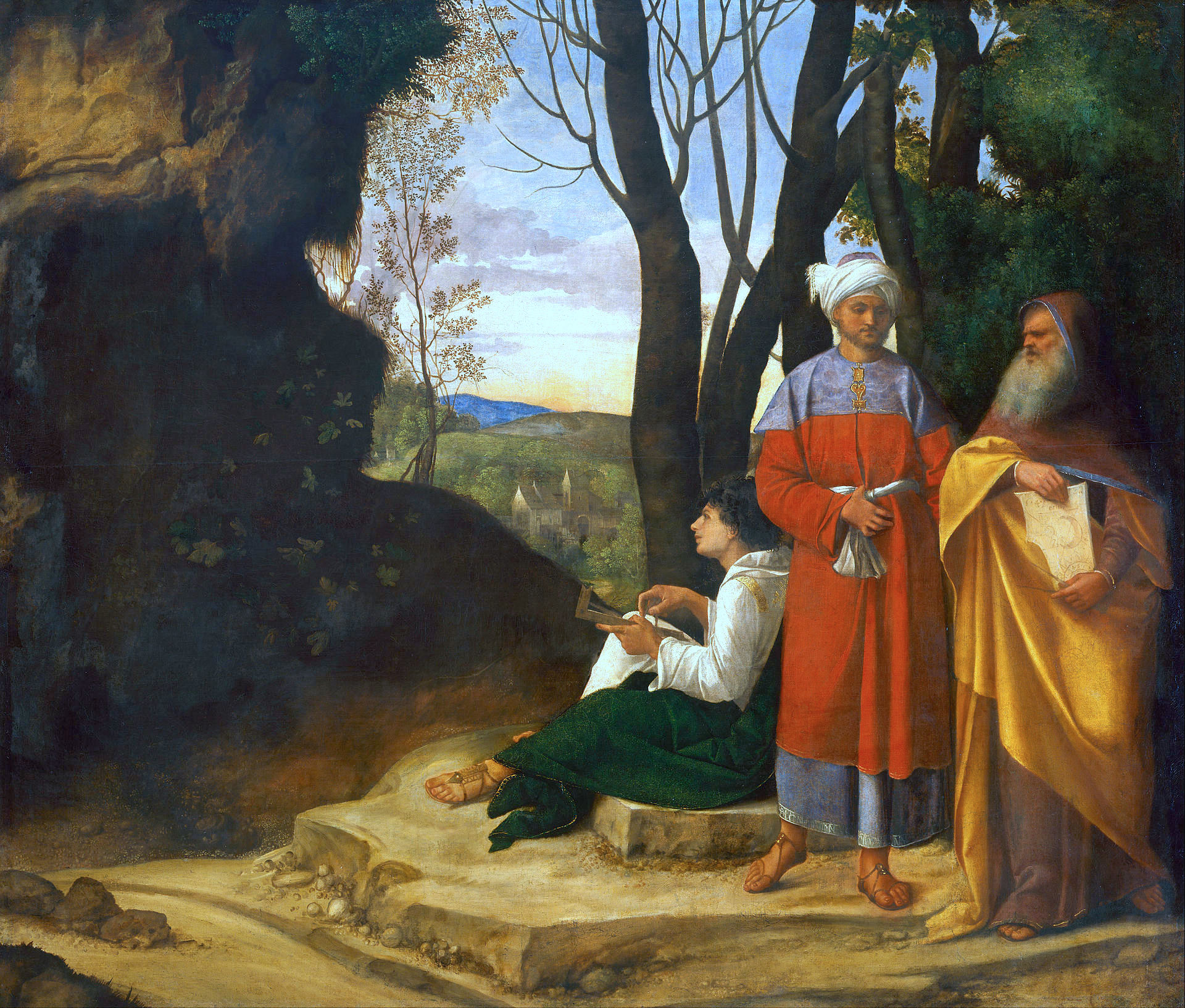
Giorgione, Three Philosophers, c. 1506–08, oil on canvas, 123 x 146 cm (Kunsthistorisches Museum, Vienna)
The first known owner of The Tempest was the wealthy Venetian nobleman and soap merchant Gabriele Vendramin. Displayed alongside antiquities and other works by Giorgione in the Vendramin palace, The Tempest likely expressed its owner’s personal magnificence, cultured taste, and intellectual acumen. Vivid effects of weather and light are signature artistic devices for the artist. For example, his Three Philosophers and so-called Sunset colorfully portray ephemeral lighting conditions that likely captivated original audiences as much as modern viewers. However, the present title of La tempesta (the storm) is a modern invention coined in 1894.
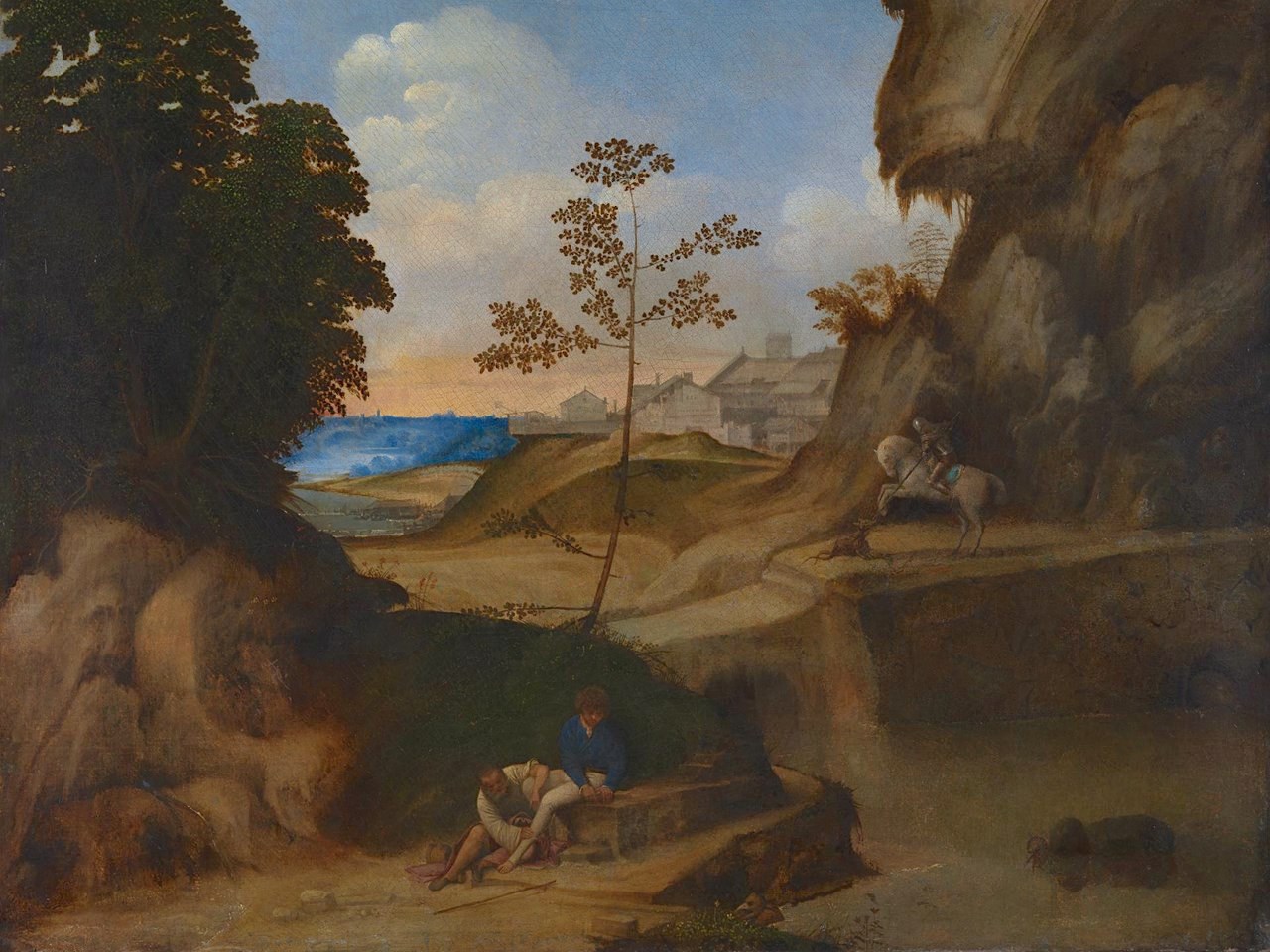
Giorgione, Sunset (“Il Tramonto”), c. 1506–10 (with 20th-century restorations), oil on canvas, 73.3 x 91.4 cm (National Gallery of Art, London)
The painting dispenses with fifteenth-century hierarchies dictating figures be given central importance in scale and composition over the landscape. Giorgione empties out the narrative core of the picture. His working method in The Tempest indicates the primary importance he designated for landscape in the overall composition. It is laid down first without any portions left reserved for figures, who are painted last and overtop the finished countryside. This unconventional choice subordinates the usual narrative elements—in this case man, woman, and infant—to the periphery. Instead, virtuoso depiction of land and atmosphere possibly stand as the true subjects of The Tempest—eclipsing any human drama.
Technical innovation
What distinguishes The Tempest from earlier small easel pictures produced in Venice is Giorgione’s exploitation of newly available painting technologies. The medium of oil paint applied to a canvas support was typically reserved for large-scale civic projects in Venice, such as those completed by the workshops of Giovanni Bellini and Vittore Carpaccio. Giorgione’s much smaller scale and format helped introduce works in this medium to private Venetian homes.
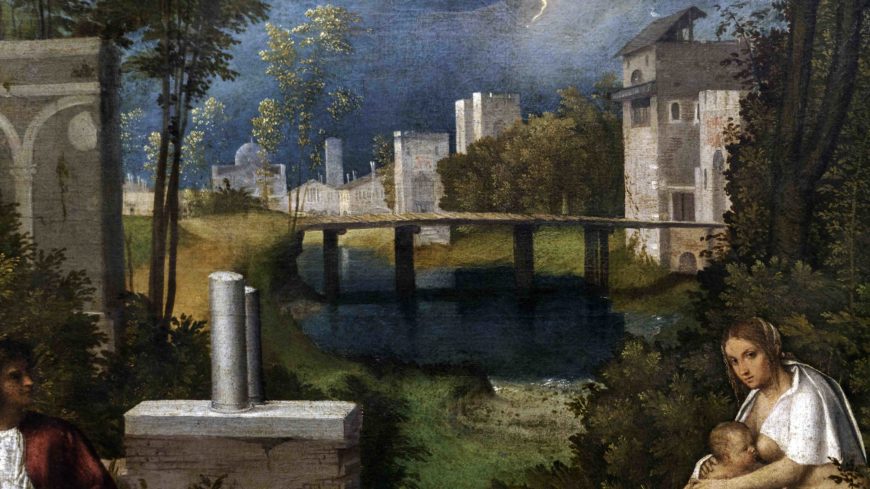
Landscape (detail), Giorgione, The Tempest, c. 1505-1508, oil with traces of tempera on canvas, 82 x 73 cm (Gallerie dell’Accademia, Venice) (photo: Steven Zucker, CC BY-NC-SA 2.0)
More specifically, The Tempest inaugurates the long Venetian tradition of painterly colore (color) as the dominant expressive element in painting, eventually embodied by Giorgione’s colleague Titian. Opposed to the Tuscan tradition of disegno (design) based on rigorous preliminary drawings for finished paintings, technical examinations of The Tempest’s canvas reveal only minimal sketches. Giorgione employed a largely improvisational approach.
In the finished work, deftly blended gradations of color, light, and tonal contrasts create an atmosphere unifying the composition. Pigment analysis reveals another unconventional choice: Giorgione’s use of mineral-based pigments (yellow orpiment and orange realgar) to achieve deep and rich colors. Touches of much drier tempera paint also occur, demonstrating his tendency toward experimentation. This textural variation results in sensuous details of flesh, thick humidity, and foliage sparkling with moisture.
Additionally, numerous pentimenti (original elements painted out in the final version) are evident. These include portions of the trees, several architectural features in the middle ground and background, parts of the male figure, and a nude woman once seated in the left foreground but omitted in the final version. This latter figure, revealed when the painting was first X-rayed in 1939, demonstrates how Giorgione might have originally intended an alternate subject matter but freely adjusted the content as the work progressed.
Modern reception and influence
The English poet Lord Byron rhapsodized about The Tempest in letters and his poem Beppo (1817), as did the Swiss cultural historian Jacob Burckhardt. Its impact is evident for Realist painters such as Edouard Manet, whose Le dèjeuner sur l’herbe (1863) was likely inspired by its pastoral setting. The American collector Isabella Stewart Gardner tried unsuccessfully to acquire “that beautiful plum” in 1896 for her future museum in Boston. [1]
The continual flood of proposals seeking to decode The Tempest tend to reveal more about the erudition of art historians than Giorgione. Nineteenth-century readings of the painting, guided by Romantic notions of creativity as the expression of individual genius, have exerted an enormous yet problematic influence over scholarship on the painting. Many theories remain dubious since they tend to over-intellectualize the artist and his intentions. There is no evidence Giorgione possessed an advanced education or university training. In this way, The Tempest serves as a fascinating barometer of art historical methodologies and trends, as successive generations grapple with its absorbing and notoriously volatile imagery.
Notes:
- Letter from Isabella Stewart Gardner to Bernard Berenson, Oct. 21, 1896, in R. van N. Hadley, ed., The Letters of Bernard Berenson and Isabella Stewart Gardner, 1887–1924 (Boston: Northeastern University Press, 1987), p. 69.
Additional Resources:
The Forgotten Genius: How Giorgione Changed Painting on ArtUK
This work at the Gallerie dell’Accademia in Venice
Read more about technical analysis of Giorgione’s Il Tramonto at the National Gallery of Art, London
Discover Giorgione’s paintings on Google Arts & Culture
Jaynie Anderson, Giorgione: The painter of ‘Poetic Brevity,’ including catalogue raisonné (New York: Flammarion, 1997)
Sylvia Ferino-Pagden and Giovanna Nepi Scirè, eds., Giorgione: Myth and Enigma (Milan: Skira, 2004)
Deborah Howard, “Giorgione’s Tempesta and Titian’s Assunta in the Context of the Cambrai Wars,” Art History 8, no. 3 (Sept., 1985), 271-89
Salvatore Settis, Giorgione’s Tempest: Interpreting the Hidden Subject, trans. Ellen Bianchini (Chicago: University of Chicago Press, 1990)
Smarthistory images for teaching and learning:
[flickr_tags user_id=”82032880@N00″ tags=”GioTemp,”]

